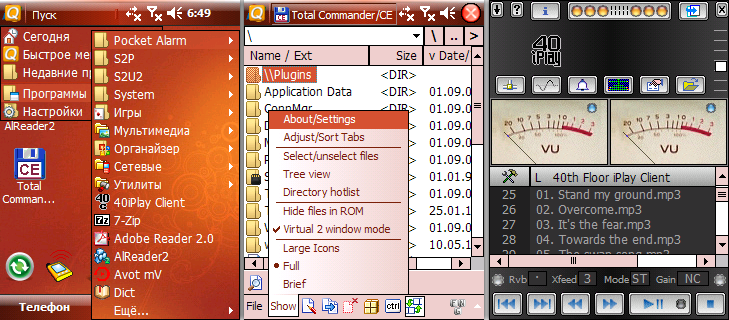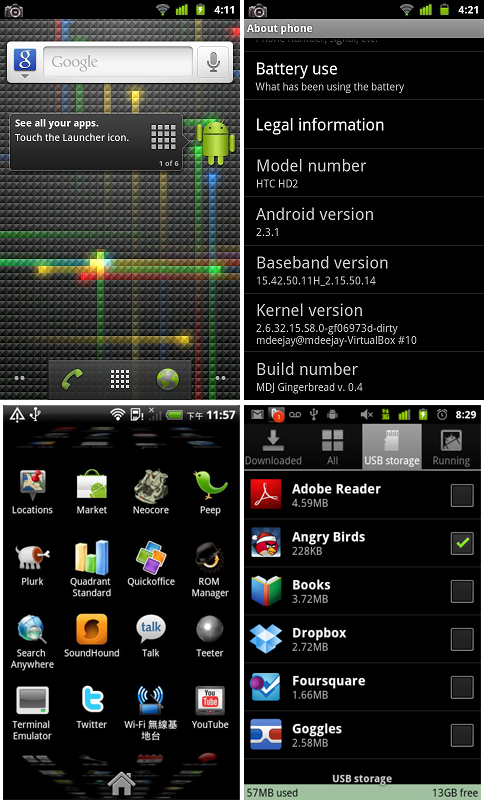Where did the PDA go?
The variety of modern mobile devices, it would seem, will allow everyone to find the device according to their needs. The development of the mobile industry leads to the emergence of new and new devices. At one time, a set of sensors like an accelerometer and an illumination sensor could be proud of; now, even a budget phone can have both the sensors listed above and a gyroscope to boot. So, just in case. However, it will not be about innovations, but about the fact that they managed to lose modern mobile devices, following trends and fashion innovations.
Can modern devices based on Android, WP or iOS be called a term thatonce played a significant role in the market - PDA? Let's try to compare the Pocket Personal Computer and the modern smartphone, for example, on Android.
As an example, I took a few screenshots from the Glofiish X500 based on Windows Mobile 6.1 and a few from a hypotheticalandroid phone with a screen resolution, albeit a little larger than that of Glofiish.

Glofish X500

A certain android device
')
Both devices have a touch screen. Suppose that there, and there it is resistive - in the case of a PDA, this is true. However, a serious difference in controls is immediately striking. Despite the fact that Android has a larger screen resolution, there are smaller active controls on it and they are larger in size. Obviously, the evolution of the interfaces "under the finger" was due to the emergence of capacitive sensors. On phones with a new type of stylus sensor, as a rule, there is no, all actions are performed with a finger, which entails changing interface elements in order to improve the notorious usability.
The capacitive sensor replaced the resistive sensor, butsome kind of replacement was required for the resistive one . Among the technologies that are comparable in accuracy, an induction sensor can be found, but its use in phones is apparently too expensive - I could not find one such phone. As a result, the phones were left without a high-precision sensor - a resistive device was used for some time, but its flaws and the mode for a capacitive sensor forced manufacturers to abandon it. Yes, it was precisely fashion and marketing that served as one of the reasons, because the first devices with capacitive screens were sometimes inconvenient to use, broke and had various other shortcomings. But multitouch.
It seems to be, so what, what's on the screen all big? But no. Periodically, when I see abig-big screen of the device, in which several letters with large indents are written in large letters - let it be a menu - I remember those phones where one screen, one visible area had much more functionality and information. The universal desire to expand, to do "under the finger" can lead, in my opinion, to an unprecedented despondency of interfaces. Yes, I compare smartphones and PDAs - but only for the reason that there is nothing to compare with.
So, with the resistive sensors leaving, unfortunately, compressed, capacious interfaces are gone. Now think of another disease of modern devices.
Why do we need
Recently, devices have been manufactured, from hardware keys, different on / off buttons and volume, havingtwo or three . On Android smartphones, this is usually the Menu and Home keys, often the Search button, other platforms have even less, excluding qwerty devices . This is clearly not enough to assign a convenient location for the keys in the player, games and other programs. You can reassign the "Search" button ... That's all. The remaining buttons are really needed to control the phone.
Now let's see how it was in the CCP:

Not so stylish? Maybe. There is no thinnest frame around the screen, indents had to be made a little more. But it justifies itself. The real key is more convenient than the on-screen one, because, for example, it will not disappear when the screen is off, it has an obvious advantage in the field of tactile sensations, it does not close part of the image on the screen. 5–6 buttons are not old and ugly, this is normal. Let the phone not look like that phone , but it will be really convenient to use it. Not always the button on the screen or on the headset can replace the most ordinary “iron” button.
This post - a kind of memories of leaving devices such as "PDA". For me personally, the functionality of the softwareandroid devices is almost enough in comparison with the software on WM. But the above factors sometimes make you think about the future of phones and mobile devices. In their development there is a certain simplification, which speaks completely not in their favor. Sooner or later, phones can turn into flat rectangles with a huge screen, one button, integration with social networks, a simple menu and a bunch of useless applications in the Market.
I don’t blame Android, iOS and WP at all. In their niche, they look very harmonious and their capabilities are quite enough for both ordinary users and advanced users.
PDA vs. smartphone
Can modern devices based on Android, WP or iOS be called a term that
As an example, I took a few screenshots from the Glofiish X500 based on Windows Mobile 6.1 and a few from a hypothetical

Glofish X500

A certain android device
')
Both devices have a touch screen. Suppose that there, and there it is resistive - in the case of a PDA, this is true. However, a serious difference in controls is immediately striking. Despite the fact that Android has a larger screen resolution, there are smaller active controls on it and they are larger in size. Obviously, the evolution of the interfaces "under the finger" was due to the emergence of capacitive sensors. On phones with a new type of stylus sensor, as a rule, there is no, all actions are performed with a finger, which entails changing interface elements in order to improve the notorious usability.
The capacitive sensor replaced the resistive sensor, but
It seems to be, so what, what's on the screen all big? But no. Periodically, when I see a
So, with the resistive sensors leaving, unfortunately, compressed, capacious interfaces are gone. Now think of another disease of modern devices.
Why do we need hardware keys ?
Recently, devices have been manufactured, from hardware keys, different on / off buttons and volume, having
Now let's see how it was in the CCP:

Not so stylish? Maybe. There is no thinnest frame around the screen, indents had to be made a little more. But it justifies itself. The real key is more convenient than the on-screen one, because, for example, it will not disappear when the screen is off, it has an obvious advantage in the field of tactile sensations, it does not close part of the image on the screen. 5–6 buttons are not old and ugly, this is normal. Let the phone not look like that phone , but it will be really convenient to use it. Not always the button on the screen or on the headset can replace the most ordinary “iron” button.
Why do you need this post?
This post - a kind of memories of leaving devices such as "PDA". For me personally, the functionality of the software
PS
I don’t blame Android, iOS and WP at all. In their niche, they look very harmonious and their capabilities are quite enough for both ordinary users and advanced users.
Source: https://habr.com/ru/post/131644/
All Articles